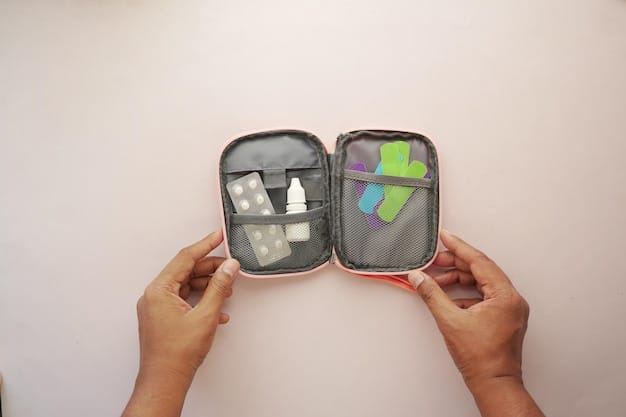International Travel Advisories: A US Citizen’s Guide to Safety

Understanding International Travel Advisories: A US Citizen’s Guide to Staying Safe Abroad involves knowing how to interpret and use travel advisories issued by the US Department of State to minimize risks and ensure safety while traveling internationally.
Planning an international trip involves more than booking flights and hotels; it requires a thorough understanding of potential risks and how to mitigate them. This is where Understanding International Travel Advisories: A US Citizen’s Guide to Staying Safe Abroad becomes essential.
Understanding the Basics of US Travel Advisories
The US Department of State issues travel advisories to inform US citizens about safety and security conditions in countries around the world. Grasping the fundamentals of these advisories is the first step in ensuring a safe and informed trip.
What are Travel Advisories?
Travel advisories are official warnings that provide information on potential risks, such as crime, terrorism, health hazards, natural disasters, and political instability. They are designed to help US citizens make informed decisions about traveling abroad.
Levels of Travel Advisories
The advisory system uses a color-coded scale to indicate the level of risk:
- Level 1 (Blue): Exercise Normal Precautions
- Level 2 (Yellow): Exercise Increased Caution
- Level 3 (Orange): Reconsider Travel
- Level 4 (Red): Do Not Travel

Each level provides specific recommendations and warnings tailored to the conditions in a particular country or region.
Travel advisories are not static; they are continuously updated based on the latest information available to the US Department of State. This means that conditions can change rapidly, and travelers should check for updates frequently, especially as their departure date approaches. By regularly monitoring these advisories, US citizens can stay informed and make timely decisions regarding their travel plans, ensuring they are well-prepared for any potential risks or challenges.
How to Read and Interpret Travel Advisories
Knowing how to effectively read and interpret travel advisories is critical for making informed decisions about your trip. These advisories contain specific language and information that can help you assess potential risks.
Key Components of a Travel Advisory
Travel advisories typically include the following:
- Overall Risk Level: The color-coded level indicating the general safety and security situation.
- Specific Risks: Detailed information on potential threats such as crime, terrorism, civil unrest, health risks, and natural disasters.
- Affected Areas: Identification of specific regions or cities within the country where the risks are higher.
- Recommended Actions: Guidance on how to stay safe, including avoiding certain areas, being vigilant in public places, and registering with the Smart Traveler Enrollment Program (STEP).
Understanding the Language Used
Pay close attention to the wording used in the advisory. Terms like “exercise increased caution” suggest vigilance, while “reconsider travel” and “do not travel” indicate more serious risks that may warrant postponing or canceling your trip.
Travel advisories often provide context by explaining why certain warnings are in place. For example, an advisory might state that a country has a high risk of terrorism due to recent attacks or ongoing threats. Similarly, advisories may highlight specific regions where crime rates are particularly high, advising travelers to avoid those areas or exercise extreme caution. Understanding these details can help you assess the actual risk level and make informed decisions based on your specific circumstances. By staying informed and considering the specific risks, US citizens can better protect themselves and ensure a safer travel experience.
Utilizing the Smart Traveler Enrollment Program (STEP)
The Smart Traveler Enrollment Program (STEP) is a free service provided by the US Department of State that allows US citizens and nationals traveling abroad to enroll their trip with the nearest US Embassy or Consulate.
Benefits of Enrolling in STEP
Enrolling in STEP offers several key advantages:
- Emergency Alerts: Receive timely alerts about safety conditions, natural disasters, or civil unrest in your destination.
- Location Assistance: In case of an emergency, the US Embassy or Consulate will know your location and be able to assist you.
- Family Notification: If an emergency occurs, the US Department of State can quickly contact your family members.
How to Enroll in STEP
Enrolling in STEP is a simple process:
- Visit the STEP website: Go to the official US Department of State STEP website.
- Create an Account: If you don’t already have one, create an account.
- Enter Trip Details: Provide information about your travel dates, destinations, and contact information.
Consider enrolling in STEP as a proactive measure to ensure your safety and security while traveling abroad.
Once enrolled, it’s essential to keep your STEP profile updated with any changes to your travel plans. This includes any adjustments to your itinerary, accommodation details, or contact information. Keeping your profile current ensures that the US Embassy or Consulate can reach you quickly and provide assistance if needed. Activating alerts is another important step, allowing you to receive real-time updates and warnings about potential risks in your destination. By taking these steps, US citizens can maximize the benefits of the STEP program and enhance their safety while traveling abroad.
Understanding Health and Medical Considerations
Health and medical considerations are vital aspects of international travel. Travel advisories often include health-related warnings and recommendations, especially during disease outbreaks or health crises.
Checking Health Advisories
Consult the Centers for Disease Control and Prevention (CDC) website for health advisories specific to your destination. These advisories provide information on:
- Vaccinations: Recommended and required vaccinations for your destination.
- Disease Outbreaks: Information on current disease outbreaks and preventive measures.
- Health Tips: General health tips for staying healthy during your trip.
Travel Insurance and Medical Evacuation
Ensure you have adequate travel insurance that covers medical emergencies and evacuation. Review the policy details to understand what is covered and what is not.

In addition to travel insurance, consider purchasing medical evacuation insurance, which covers the cost of transporting you to a medical facility in case of a serious illness or injury.
Access to healthcare can vary significantly from one country to another. In some destinations, high-quality medical care may be readily available, while in others, it may be limited or difficult to access. Research the healthcare system in your destination and identify reputable hospitals and clinics. If you have any pre-existing medical conditions, consult with your doctor before traveling to ensure you are fit to travel and have all necessary medications and supplies. Additionally, learn about any potential health risks specific to your destination, such as mosquito-borne illnesses or foodborne diseases, and take appropriate precautions to protect yourself.
Navigating High-Risk Areas and Situations
Some destinations or situations may pose higher risks to travelers. Knowing how to navigate these challenges is crucial for your safety.
Researching Specific Risks
Different regions may have particular risks. Research the specific areas you plan to visit:
- Crime: Understand the types of crime prevalent in the area and take precautions to protect your belongings.
- Political Instability: Avoid areas with ongoing political unrest or demonstrations.
- Terrorism: Be vigilant in public places and transportation hubs.
Staying Informed and Vigilant
During your trip, stay informed about local news and events. Be aware of your surroundings and report any suspicious activity to the authorities.
Avoid drawing unnecessary attention to yourself and take steps to blend in with the local population. Dress modestly, avoid wearing expensive jewelry or displaying large sums of money, and be mindful of local customs and traditions. Trust your instincts and avoid situations that feel unsafe or uncomfortable. Plan your routes in advance and stick to well-lit, populated areas, especially at night. By staying informed, vigilant, and respectful of local customs, US citizens can minimize their risk of encountering trouble and enjoy a safer travel experience.
Staying Safe During Natural Disasters
Natural disasters can occur unexpectedly and pose significant risks to travelers. Knowing how to prepare for and respond to such events is essential for your safety.
Preparing for Natural Disasters
Before traveling, check the weather forecast and hazard warnings for your destination. Be aware of the types of natural disasters that are common in the area, such as hurricanes, earthquakes, or floods.
During a Natural Disaster
If a natural disaster occurs during your trip:
- Follow Local Authorities: Obey instructions from local authorities and emergency responders.
- Seek Shelter: Find a safe place to shelter, such as a designated evacuation center or a sturdy building.
- Stay Informed: Monitor local news and weather updates for the latest information.
Develop a communication plan with your family members so they know how to reach you in case of an emergency.
| Key Point | Brief Description |
|---|---|
| 🚨 Travel Advisories | Official warnings from the US Department of State about safety and security conditions abroad. |
| 📝 STEP Enrollment | Register with the Smart Traveler Enrollment Program for emergency alerts and assistance. |
| 🩺 Health Checks | Consult CDC for health advisories, vaccinations, and disease outbreak information. |
| 🌍 Local Awareness | Stay informed about local news, customs, and potential risks in your destination. |
International Travel Advisories: FAQs
▼
A travel advisory is an official warning issued by the US Department of State to inform US citizens about potential risks in foreign countries.
▼
You can enroll in STEP by visiting the US Department of State’s STEP website and creating an account to register your trip details.
▼
Follow instructions from local authorities, seek shelter in a safe location, and stay informed via local news and weather updates.
▼
Yes, having travel insurance is highly recommended to cover medical emergencies, evacuations, and unexpected trip disruptions.
▼
You can find health advisories specific to your destination on the Centers for Disease Control and Prevention (CDC) website.
Conclusion
Understanding International Travel Advisories: A US Citizen’s Guide to Staying Safe Abroad is crucial for ensuring a safe and informed travel experience. By staying informed, enrolling in STEP, and taking appropriate precautions, US citizens can minimize risks and enjoy their international adventures with greater peace of mind.





